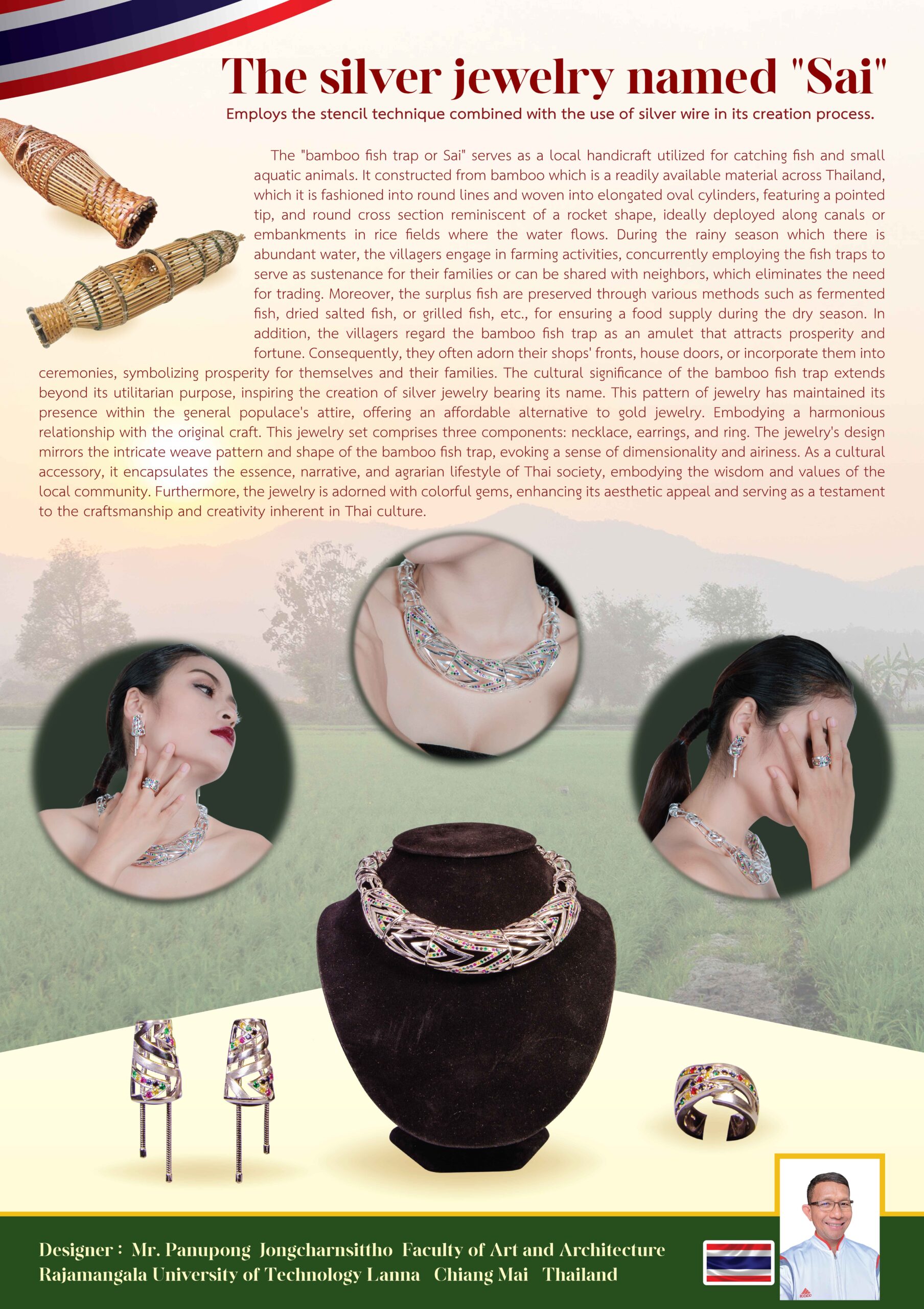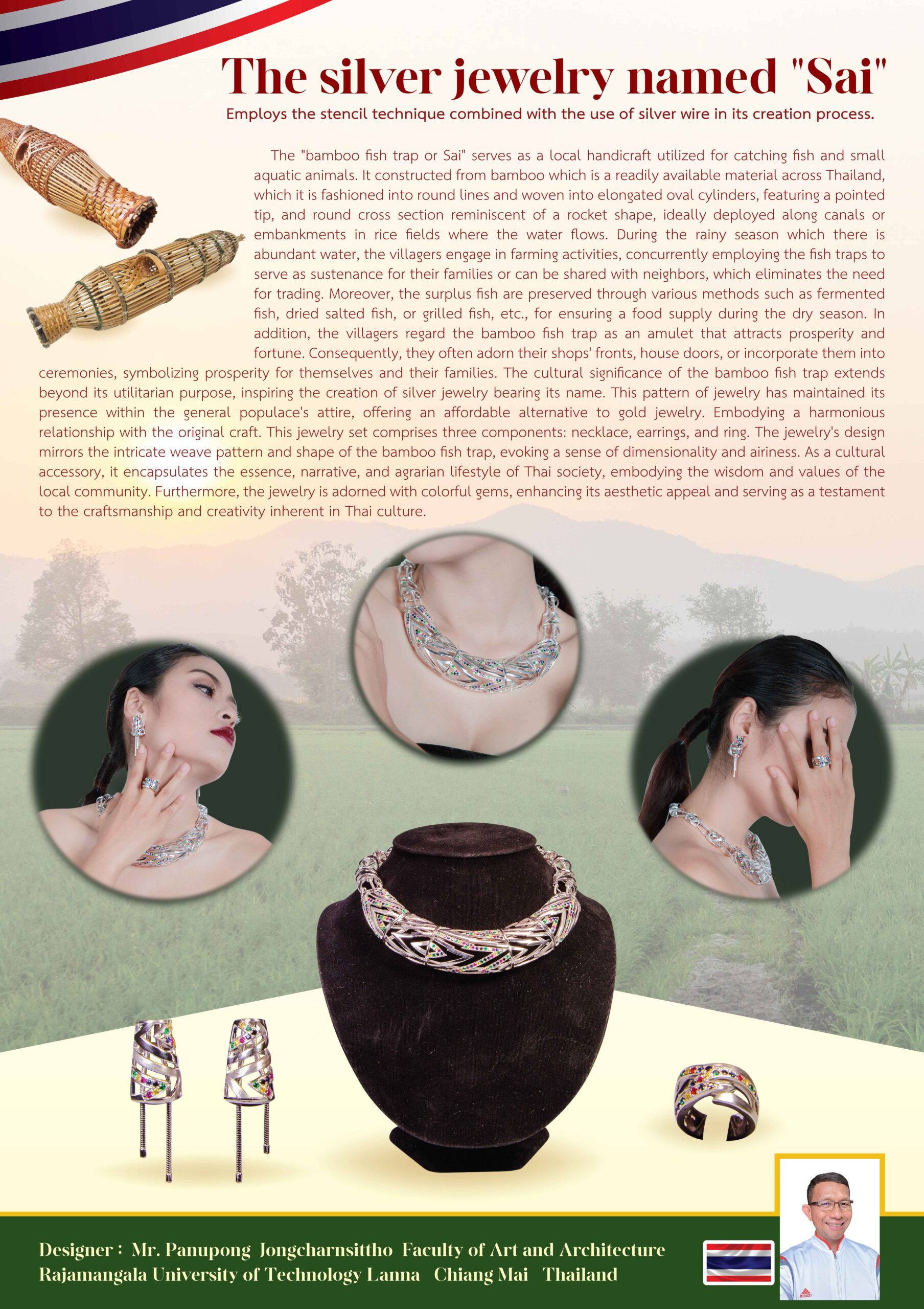
Asst. Prof. Dr. Panupong Jongcharnsittho

Abstract :
The “bamboo fish trap or Sai” serves as a local handicraft utilized for catching fish and small aquatic animals. It constructed from bamboo which is a readily available material across Thailand, which it is fashioned into round lines and woven into elongated oval cylinders, featuring a pointed tip, and round cross section reminiscent of a rocket shape, ideally deployed along canals or embankments in rice fields where the water flows. During the rainy season which there is abundant water, the villagers engage in farming activities, concurrently employing the fish traps to serve as sustenance for their families or can be shared with neighbors, which eliminates the need for trading. Moreover, the surplus fish are preserved through various methods such as fermented fish, dried salted fish, or grilled fish, etc., for ensuring a food supply during the dry season. In addition, the villagers regard the bamboo fish trap as an amulet that attracts prosperity and fortune. Consequently, they often adorn their shops’ fronts, house doors, or incorporate them into ceremonies, symbolizing prosperity for themselves and their families. The cultural significance of the bamboo fish trap extends beyond its utilitarian purpose, inspiring the creation of silver jewelry bearing its name. This pattern of jewelry has maintained its presence within the general populace’s attire, offering an affordable alternative to gold jewelry. Embodying a harmonious relationship with the original craft. This jewelry set comprises three components: necklace, earrings, and ring. The jewelry’s design mirrors the intricate weave pattern and shape of the bamboo fish trap, evoking a sense of dimensionality and airiness. As a cultural accessory, it encapsulates the essence, narrative, and agrarian lifestyle of Thai society, embodying the wisdom and values of the local community. Furthermore, the jewelry is adorned with colorful gems, enhancing its aesthetic appeal and serving as a testament to the craftsmanship and creativity inherent in Thai culture.
Objectives :
This jewelry set comprises three components: necklace, earrings, and ring. The jewelry’s design mirrors the intricate weave pattern and shape of the bamboo fish trap, evoking a sense of dimensionality and airiness. As a cultural accessory, it encapsulates the essence, narrative, and agrarian lifestyle of Thai society, embodying the wisdom and values of the local community. Furthermore, the jewelry is adorned with colorful gems, enhancing its aesthetic appeal and serving as a testament to the craftsmanship and creativity inherent in Thai culture.
Conceptual Framework :
- Design Principle
- Design of silver jewelry
- Tangible cultural
- Lanna Cultural
- Art Composition
Process / Methodology :
1.Content analysis of the cultural capital of the area
2.Sketch of a silver jewelry design
3.Creation of jewelry items
4. showcasing designs for silver jewelry during the show in the exhibition
Techniques and Materials :
Employs the stencil technique combined with the use of silver wire in its creation process.
Result / Conclusion :
This jewelry set comprises three components: necklace, earrings, and ring. The jewelry’s design mirrors the intricate weave pattern and shape of the bamboo fish trap, evoking a sense of dimensionality and airiness. As a cultural accessory, it encapsulates the essence, narrative, and agrarian lifestyle of Thai society, embodying the wisdom and values of the local community. Furthermore, the jewelry is adorned with colorful gems, enhancing its aesthetic appeal and serving as a testament to the craftsmanship and creativity inherent in Thai culture.
References :
- Department of Cultural Promotion.(2020). Value culture to value. Retrieved 22 March 2024. fromhttps://www.culture.go.th/culture_th/ewt_news.php?nid=3972&filename=index
- Jewelry Design.(2024). Retrieved 20 March 2024. From https://www.salamanderjewelry.co.th/?page_id=6607.
- Saraswadi Ongsakul.(2014). Lanna history. (10 th printing). Bangkok: Amarin Printing and Publishing.